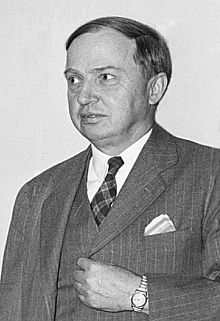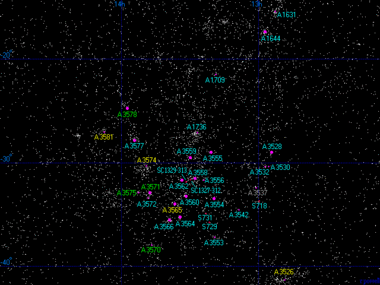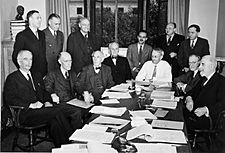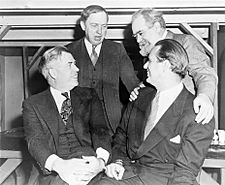Harlow Shapley facts for kids
Quick facts for kids
Harlow Shapley
|
|
|---|---|
 |
|
| Born | November 2, 1885 Nashville, Missouri, U.S.
|
| Died | October 20, 1972 (aged 86) Boulder, Colorado, U.S.
|
| Alma mater | University of Missouri, Princeton University |
| Known for | Determining correct position of Sun within Milky Way Galaxy; head of Harvard College Observatory (1921–1952) |
| Children | 5, including
|
| Awards |
|
| Scientific career | |
| Fields | Astronomy |
| Doctoral advisor | Henry Norris Russell |
| Doctoral students | Cecilia Payne-Gaposchkin, Carl Seyfert |
| Other notable students | Georges Lemaître |
Harlow Shapley (born November 2, 1885 – died October 20, 1972) was an important American scientist. He was the director of the Harvard College Observatory from 1921 to 1952. He also took part in political activities, especially in the 1940s.
Shapley used special stars called Cepheid variables to figure out how big our home galaxy, the Milky Way Galaxy, is. He also found the Sun's place within it. He did this using a method called parallax, which measures distances to stars. In 1953, he came up with an idea about a "liquid water belt." This idea is now known as the habitable zone, which is the area around a star where conditions are just right for liquid water to exist, making life possible.
Contents
Early Life and Education
Harlow Shapley was born on a farm near Nashville, Missouri. He only went to elementary school. After that, he studied at home and worked as a newspaper reporter. He covered crime stories for papers in Kansas and Missouri.
While working, he found a library and started reading and learning on his own. He then went back to school and finished a six-year high school program in just 1.5 years! He was the top student in his class.
In 1907, Shapley went to the University of Missouri to study journalism. But the journalism school's opening was delayed. So, he looked through the course list and picked the first subject he saw that wasn't archaeology (which he said he couldn't even pronounce!). That subject was Astronomy.
Studying the Stars
After college, Shapley received a special scholarship to Princeton University. There, he studied with a famous astronomer named Henry Norris Russell. Shapley used the way Cepheid variable stars change brightness (a discovery by Henrietta Swan Leavitt) to measure distances to groups of stars called globular clusters.
He helped astronomers understand that Cepheid stars actually pulse, or swell and shrink, instead of being two stars orbiting each other. This was a big step forward in understanding these important stars.
He also realized that the Milky Way Galaxy was much, much bigger than people thought. He discovered that our Sun is not at the center of the galaxy, but in a regular, everyday spot. This idea supports the Copernican principle, which says that Earth is not the center of everything.
The Great Debate of 1920
In 1920, Shapley took part in a famous discussion called the "Great Debate." He debated with another astronomer named Heber D. Curtis. They argued about what "spiral nebulae" were (these are now known as galaxies) and how big the Universe is.
Shapley believed that these spiral nebulae were inside our own Milky Way Galaxy. Curtis, however, thought they were "island universes," meaning they were separate galaxies far outside our Milky Way and similar to it in size. This debate helped start the study of extragalactic astronomy, which is the study of objects outside our galaxy.
Who Won the Debate?
The debate happened on April 26, 1920, in Washington D.C. Shapley's actual talk was different from what he later published. Some historians believe he made his talk very simple to impress people from Harvard who were thinking of hiring him.
Because of this, Curtis was seen as winning the debate. Soon after, Edwin Hubble found Cepheid variable stars in the Andromeda Galaxy. This discovery proved that Andromeda was indeed a separate galaxy, confirming Curtis's view.
After the debate, Shapley was hired to become the director of the Harvard College Observatory (HCO).
Leading Harvard College Observatory
Harlow Shapley was the director of the HCO from 1921 to 1952. During his time there, he made some important decisions.
He hired Cecilia Payne, who in 1925 became the first person to earn a doctorate degree in astronomy from Radcliffe College. She did her amazing work at the Harvard College Observatory.
Shapley also helped create scientific groups that received government funding, like the National Science Foundation. He is also given credit for adding the "S" (for Scientific) to UNESCO (United Nations Educational, Scientific and Cultural Organization).
Views on Other Galaxies
At first, Shapley didn't believe Edwin Hubble's observations that there were other galaxies besides the Milky Way. He thought Hubble's work wasn't good science.
However, when Hubble sent him a letter showing clear evidence of a Cepheid variable star in the Andromeda galaxy, Shapley changed his mind. He reportedly told a friend, "Here is the letter that destroyed my universe." He then encouraged Hubble to share his findings, which completely changed how scientists saw the universe.
Even though he had disagreed at first, Shapley went on to do important research on how galaxies are spread out in space. Between 1925 and 1932, he and his team at Harvard College Observatory mapped 76,000 galaxies. He was one of the first astronomers to believe in the existence of superclusters of galaxies. He even discovered a very large and distant one, which was later named the Shapley Supercluster. His estimate for its distance was very close to what we know today.
Personal Life
Shapley married Martha Betz in 1914. She was also an astronomer and helped him with his research at both Mount Wilson and Harvard Observatory. She wrote many articles about stars that change brightness.
They had five children: one daughter and four sons. One of their sons, Lloyd Shapley, became a mathematician and economist and won a Nobel Prize in 2012. Another son, Willis Shapley, became a leader at NASA. His oldest granddaughter, June Lorraine Matthews, became a physicist.
Harlow Shapley was interested in religion, even though he didn't follow one himself. He passed away in Boulder, Colorado, on October 20, 1972, just before his 87th birthday.
Awards and Recognition
Harlow Shapley received many awards for his work in astronomy:
- Henry Draper Medal (1926)
- Prix Jules Janssen (1933)
- Rumford Prize (1933)
- Gold Medal of the Royal Astronomical Society (1934)
- Bruce Medal (1939)
- Janssen Medal (1940)
- Pius XI Medal (1941)
- Franklin Medal (1945)
- Henry Norris Russell Lectureship (1950)
Legacy

Several things in space are named after Harlow Shapley:
- The crater Shapley on the Moon
- The Asteroid 1123 Shapleya
- The Shapley Supercluster (a huge group of galaxies)
- The Harlow Shapley Visiting Lectureships In Astronomy, given by the American Astronomical Society
Works
Shapley wrote many books about astronomy and science. One important book was Source Book in Astronomy (1929), which he wrote with Helen E. Howarth. This was the first book in a series about the history of science.
In 1953, he wrote about his "Liquid Water Belt" idea, which helped explain the ecosphere theory.
In his 1957 book Of Stars and Men, Shapley used the word Metagalaxies for what we now call superclusters.
See also
 In Spanish: Harlow Shapley para niños
In Spanish: Harlow Shapley para niños




